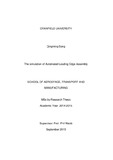JavaScript is disabled for your browser. Some features of this site may not work without it.
| dc.contributor.advisor | Webb, Phil | |
| dc.contributor.author | Song, Qingming | |
| dc.date.accessioned | 2015-12-21T15:17:04Z | |
| dc.date.available | 2015-12-21T15:17:04Z | |
| dc.date.issued | 2015-09 | |
| dc.identifier.uri | http://dspace.lib.cranfield.ac.uk/handle/1826/9614 | |
| dc.description.abstract | Aircraft manufacturers are experiencing a fierce competition worldwide. Improving productivity, increasing throughput and reducing costs are influencing aircraft manufacturer’s future development. In order to improve competitiveness and provide sufficient and high quality products, it should reduce operations of aircraft assembly,majority of which are still in manual process, which limit production output. In contrast, these processes can be automated to replace manual operations. Much more attention should be placed on automated application. This project aims to propose a methodology to develop the automated assembly based on robotics and use this methodology to develop a new concept of Automated Leading Edge Assembly. The research selects an automated assembly process for further evaluation and brackets assembled on the front spar of Leading Edge are chosen to be automated assembly with robot assistant. The software DELMIA is used to develop and simulate the automated assembly process of brackets based on 3-D virtual aircraft Leading Edge models. The research development is mainly divided into three phases which are: (1) The state of art on Manual Leading Edge Assembly; (2) Automated Leading Edge Assembly framework development; (3) Automated Leading Edge Assembly framework evaluation including automated assembly process simulation based on DELMIA robotics workbench and automated assembly cost estimation. The research has proposed a methodology to develop the automated assembly based on robotics, proposed a new concept of Automated Leading Edge Assembly: using robots to replace workers to finish the assembly applications in the Leading Edge, and proposed a new automated bracket assembly process with laser ablation, adhesive bonding, drilling, riveting, and robot application. These applications can attract more and more engineers’ attention and provide preliminary knowledge for further study and detail research in the future. | en_UK |
| dc.language.iso | en | en_UK |
| dc.publisher | Cranfield University | en_UK |
| dc.rights | © Cranfield University, 2015. All rights reserved. No part of this publication may be reproduced without the written permission of the copyright holder. | en_UK |
| dc.subject | Automaton application | en_UK |
| dc.subject | Automated leading edge assembly | en_UK |
| dc.subject | Robotics | en_UK |
| dc.subject | Automated assembly process | en_UK |
| dc.subject | Laser ablation | en_UK |
| dc.subject | Adheisive bonding | en_UK |
| dc.subject | Simulation | en_UK |
| dc.subject | Cost estimation | en_UK |
| dc.title | The simulation of automated leading edge assembly | en_UK |
| dc.type | Thesis or dissertation | en_UK |
| dc.type.qualificationlevel | Masters by Research | en_UK |
| dc.type.qualificationname | MSc by Research | en_UK |
